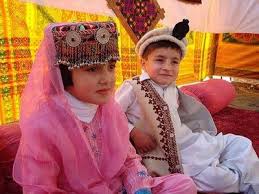Culture:
Gilgit-Baltistan is home to a wide range of ethnic and linguistic groups, which contributes to the region's rich and diversified cultural legacy. The region also has a rich history and geographical history. A distinctive fusion of Tibetan, Central Asian, and South Asian traditions defines Gilgit-culture. Baltistan's
Gilgit-music, Baltistan which includes traditional songs and dances performed on various occasions like weddings, festivals, and religious events, is one of the most notable facets of its culture. Typical traditional instruments accompanying the music include the rubab, sarangi, and dhol.
Gilgit handicrafts, Baltistan's which include complex weaving, embroidery, and woodwork, are a significant part of its culture. The area is particularly renowned for its distinctive clothing, which includes vibrant shawls, hats, and Gilgit-Baltistan is home to a wide range of ethnic and linguistic groups, which contributes to the region's rich and diversified cultural legacy. The region also has a rich history and geographical history. A distinctive fusion of Tibetan, Central Asian, and South Asian traditions defines Gilgit culture. Baltistan's
turbans, etc.
Gilgit-culture Baltistan's is heavily influenced by religion, with Islam being the predominant religion practised there. Nonetheless, there are sizable numbers of Shia Muslims and Ismaili Muslims as well.
The terrain of Gilgit-Baltistan has an impact on the food, which features breads, rice pilafs, and stewed meats. Yak meat is popular in the area and is considered to be delicious.
In the end, Gilgit-festivals Baltistan's and festivities highlight the area's rich cultural diversity. The Urs of a number of Sufi saints and the Shandur Polo Festival are among the most important occasions to celebrate.
GB culture Dress:

Women Dress:
The traditional cap is the most elegant part of the women's dress in Gilgit Baltistan. Various types of caps are used. The most popular cap is the beautiful embroidered Iraghi cap with the traditional piece of jewel called silsila.Depending on the unique ethnic group and region, different women in Gilgit-Baltistan wear different traditional attire. Nonetheless, many of the traditional dresses have a few distinctive features.
The shalwar kameez, a long tunic worn with baggy pants, is one of the most popular outfits. The tunic is frequently worn with a vibrant shawl or dupatta draped over the head or shoulders, and it may be embellished with dexterous embroidery or beading.
Women may also don a traditional head covering or hat in some areas, such as the Pakol, a woollen cap worn by women in the Hunza valley. The cap is frequently embellished with elaborate needlework and is seen as a mark of pride and identity.
Women in Gilgit-Baltistan also wear a long skirt known as the phiran, which is made of wool or cotton and frequently adorned with vibrant colours and designs, in addition to the shalwar kameez. A matching shawl or dupatta is generally worn with the phiran.
Women in some regions also don the chapan, a long, flowing coat made of wool or silk, which is a traditional costume. The chapan, which is worn over a shalwar kameez or phiran, is frequently embellished with elaborate embroidery.
Generally, Gilgit-traditional Baltistan's attire for ladies is bright and vivid, representing the area's extensive cultural past.
Men Dress:
 In Gilgit-Baltistan, the traditional attire for men differs according to the particular ethnic group and area. Nonetheless, many of the traditional dresses have a few distinctive features.
In Gilgit-Baltistan, the traditional attire for men differs according to the particular ethnic group and area. Nonetheless, many of the traditional dresses have a few distinctive features.The shalwar kameez, a long tunic worn with baggy pants, is one of the most popular outfits. The tunic, which is frequently worn with a waistcoat or vest, can be plain or embellished with exquisite embroidery or beading.
Men may also don a traditional cap or hat, such as the Pakol or the Karakul, in select areas. The Karakul is a fur hat fashioned from the wool of the Karakul sheep, whereas the Pakol is a woollen cap with a characteristic shape.
In addition to the shalwar kameez, men in Gilgit-Baltistan also wear a long coat called the chugha or shervani. The chugha is made of wool or silk and is often decorated with embroidery or beading. The shervani, on the other hand, is a long coat made of silk or cotton and is often worn on formal occasions.
Men also wear a long scarf called the lohi or dupatta, which is draped over the shoulders and can be used to protect against the cold weather.
Overall, the traditional dress for men in Gilgit-Baltistan is functional and practical, reflecting the rugged terrain and harsh climate of the region. At the same time, the use of vibrant colors and intricate embroidery or beading also reflects the rich cultural heritage of the region.
Wow
ReplyDeletenyc
ReplyDelete